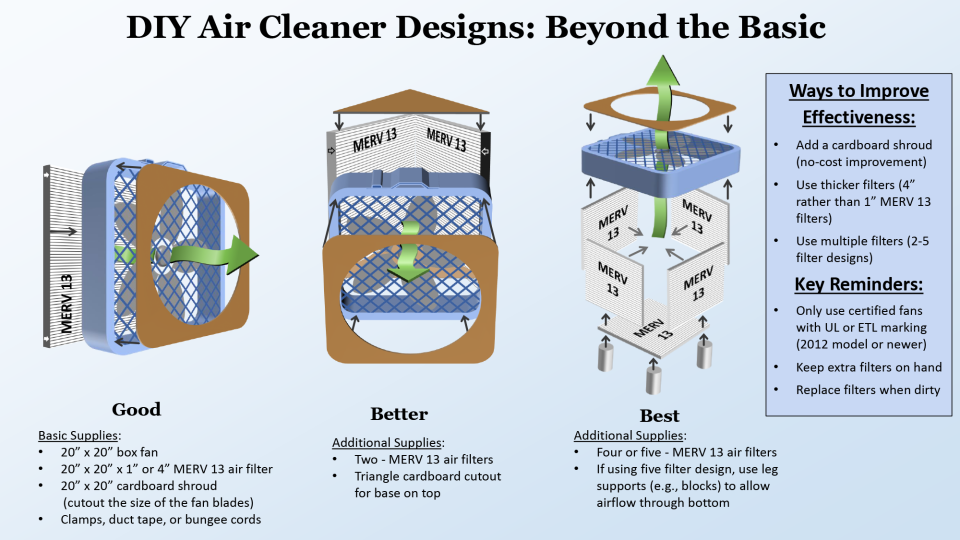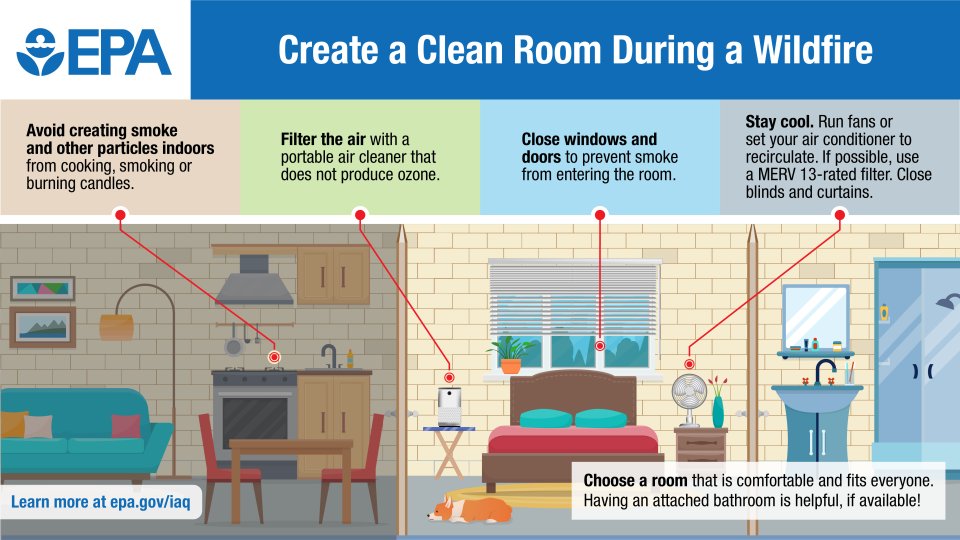Wildland Fires and Smoke
Smoke from wildland fires can degrade air quality in the United States. EPA, the U.S. Forest Service, and other federal, state and local agencies and organizations are working together to share ways that you can help protect your health from wildland fire smoke. You can use the resources on this page to prepare for and protect yourself from wildland fire smoke.
On this page:
- Wildland Fire Basics
- AirNow Resources
- Wildland Fire Smoke and Indoor Air Quality
- Wildfire and Smoke Research
Wildland Fire Basics
What is a wildland fire?
A wildland fire is any fire that occurs in an area where there is little to no human activity or development. These areas can include forests, shrublands, grasslands, or wetlands.
Wildland fires include:
- Wildfires, which are unplanned and can be started naturally – such as by lightning or volcanoes – or through accidental or unauthorized actions by humans.
- Prescribed fires, which are planned fires ignited by experts, are used for several beneficial objectives, including reducing fuels to limit the size of future wildfires.
While everyone can be affected by wildland fire smoke, healthy people are usually not at a major risk from wildland fire smoke. However, people with heart or lung disease, older adults, children and teenagers, and people who are more likely to be exposed are at increased risk of experiencing health effects. There is evidence that pregnant women and those who have limited access to measures to reduce their exposure also may be at greater risk of health impacts. Symptoms may include burning eyes, runny nose, and illnesses such as bronchitis.
AirNow Resources
What is the AirNow Fire and Smoke Map?

EPA and the U.S. Forest Service develop the AirNow Fire and Smoke Map to provide the public with information on fire locations, smoke plumes, near real-time air quality, Smoke Outlooks and actions people can take to protect their health — all in one place.
EPA and the Forest Service work to continuously improve the map and the data it displays.
You can view the Fire and Smoke Map online or by tapping the smoke icon on the bottom right of the AirNow mobile app.
What is the U.S. Air Quality Index?
The U.S. Air Quality Index is EPA's color-coded tool for communicating about outdoor air quality and health. When you know the AQI in your area, you can take steps to protect your health. Look up your area's AQI today! EPA issues an AQI for five pollutants: particle pollution, ozone, carbon monoxide, nitrogen dioxide and sulfur dioxide. You can see your current air quality and forecast for ozone and particle pollution on the AirNow.gov website, or in the free AirNow smartphone app.
Is there a resource that will help me explain how wildfires impact air quality and health to children?

Yes! Check out Why is Coco Red?
Children’s lungs are still growing and developing, so they are especially vulnerable to wildfire smoke.
Why is Coco Red? is a picture book for children. Read how Coco, his little sister and his friends solve a mystery as they learn about how wildfires can affect air quality and health. This book is for all children, especially those with asthma, and their caretakers.
Visit AirNow to read Why is Coco Red? in Spanish, Simplified Chinese, Traditional Chinese, Korean, Navajo, Tagalog, and Vietnamese. The Why is Coco Red? video is available on YouTube in English or Spanish.
Where should I go for wildfire and smoke information?
- Visit AirNow’s Wildfires page to learn what to do before, during and after a wildfire.
- Check the AirNow Fire and Smoke Map for up-to-date air quality information.
- Download the AirNow App and use it to check the AirNow Fire and Smoke Map.
- Sign up for alerts: check with your state or local or Tribal air quality agency to find out how you can sign up for local air quality alerts.
- Check for Smoke Outlooks.
- Visit EPA’s Smoke-Ready Toolbox for a full list of wildfire-related resources.
Test Your Knowledge 1
E is the correct answer.
Hey... No Peeking!
You need to select an answer to the question before we'll show you the right answer...
Wildland Fire Smoke and Indoor Air Quality
During a wildfire, smoke can make the outdoor air unhealthy to breathe. Local officials may advise you to stay indoors during a smoke event. However, you should be aware that some of the smoke from outdoors can enter your home and make it unhealthy to breathe indoor air, too.

What is a good way to protect indoor air quality during and after a wildfire smoke event?
- Use a portable air cleaner in individual rooms. Run it as often as possible on the highest fan speed. Be sure to get a portable cleaner that is the right size for the room in which you will use it and make sure the portable air cleaner does not produce ozone.
- If you have central heat or air conditioning, you can install a high-efficiency filter. Run the system's fan as often as possible to filter the outdoor air.
- Check the filters frequently and replace them when they are dirty.
- Learn more about air cleaners and filters with EPA's Guide to Air Cleaners in the Home.
- You can set up a specific room as a "clean room" where you keep levels of smoke and other particles as low as possible during wildfire smoke events. Learn more about how to create a clean room at home.
Where can I learn more about wildfires and indoor air quality?
Visit the Wildfires and Indoor Air Quality (IAQ) website (available in 9 languages) for information on:
- How wildfire smoke affects indoor air quality.
- How to prepare for fire season.
- The Prepare for Fire Season (pdf) (214 KB) fact sheet describes the key steps you should take to make sure you are prepared to protect your family's health in the event of a wildfire, such as preparing to create a "clean room" and purchasing a portable air cleaner. FEMA's How to Prepare for a Wildfire website provides additional details on how to protect yourself and your property.
- How to reduce your exposure to smoke indoors.
- The Reduce Your Smoke Exposure (pdf) (817 KB) fact sheet describes what you can do to reduce your exposure to wildfire smoke, such using a portable air cleaner.
- How to reduce your exposure from ash indoors after a wildfire smoke event.
- The Protect Yourself from Ash (pdf) (829 KB) fact sheet describes how you can protect yourself and your family and avoid getting ash in the indoor air while cleaning up.
What if a portable air cleaner isn't available or it is outside your budget?
You may choose to use a do-it-yourself air cleaner. DIY air cleaners are made by attaching a furnace filter to a box fan with tape, brackets, or a bungee cord, and can serve as a temporary alternative to commercial air cleaners.
Multiple studies indicate that well-built DIY air cleaners can be of comparable effectiveness to commercial air cleaners in reducing airborne particles such as those in wildfire smoke. However, their performance can vary based on the chosen design and the quality of the materials and assembly. Because of this, EPA does not recommend the routine use of DIY air cleaners as a permanent alternative to products of known performance (such as commercially available portable air cleaners). For more information, see EPA's Research on DIY Air Cleaners to Reduce Wildfire Smoke Indoors.


Additional Resources on Wildfires and Indoor Air Quality
- Wildfires and Indoor Air Quality
- EPA Resources about Wildfires and Indoor Air Quality
- Wildfires and Indoor Air Quality in Schools and Commercial Buildings
Test Your Knowledge 2
B is the correct answer.
Hey... No Peeking!
You need to select an answer to the question before we'll show you the right answer...
Wildfire and Smoke Research
Why is wildfire research necessary in order to protect human health and the environment?
The West and other parts of the U.S. have experienced significant smoke from wildfires. EPA is using its expertise in air quality research to fill the gaps in scientific information and to develop tools to prevent and reduce the impact of smoke from wildfires and controlled or prescribed burns.
Visit Wildland Fire Research to Protect Health and the Environment to learn about the varying research areas, featured research and activities, and scientific publications.

What is an example of the wildfire smoke research being done by EPA and its partners?
EPA is conducting research to provide actionable information to help Americans stay safe during a wildfire. Everyone deserves access to cleaner indoor air during wildfire smoke events. But when there are smoky conditions from wildfires, commercial air cleaners can be difficult to obtain because of limited availability or high cost. EPA conducted research to evaluate DIY air cleaners to answer questions from EPA partners and the public about their effectiveness and safety.
This research is one part of a study called the Wildfire Advancing Science Partnerships for Indoor Reductions of Smoke Exposures Study. The objectives of the Wildfire ASPIRE Study are to better understand indoor air quality during smoke episodes and evaluate the effectiveness of interventions for reducing indoor smoke exposures and related public health risks.

What is Smoke-Ready Communities research?

EPA and the U.S. Forest Service led a unique multidisciplinary and interagency study that is expected to offer assistance with planning for smoke events from fires. The research project involves community partners in a collaborative process to create community smoke response plans that can be implemented during smoky conditions. The partners were the city and county of Butte and Silver Bow in Montana, and Garfield County in Colorado, two areas increasingly impacted by wildfires.
Learn more at Smoke-Ready Communities.
Test Your Knowledge 3
D is the correct answer.
Hey... No Peeking!
You need to select an answer to the question before we'll show you the right answer...


